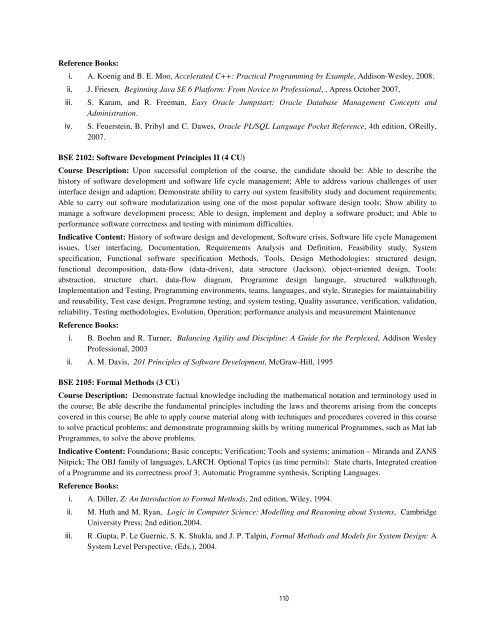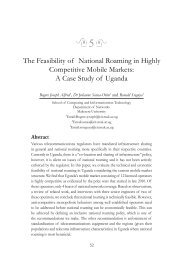Undergraduate Handbook - School of Computing and Informatics ...
Undergraduate Handbook - School of Computing and Informatics ...
Undergraduate Handbook - School of Computing and Informatics ...
Create successful ePaper yourself
Turn your PDF publications into a flip-book with our unique Google optimized e-Paper software.
Reference Books:<br />
i. A. Koenig <strong>and</strong> B. E. Moo, Accelerated C++: Practical Programming by Example, Addison-Wesley, 2008.<br />
ii. J. Friesen, Beginning Java SE 6 Platform: From Novice to Pr<strong>of</strong>essional, , Apress October 2007,<br />
iii. S. Karam, <strong>and</strong> R. Freeman, Easy Oracle Jumpstart: Oracle Database Management Concepts <strong>and</strong><br />
Administration.<br />
iv. S. Feuerstein, B. Pribyl <strong>and</strong> C. Dawes, Oracle PL/SQL Language Pocket Reference, 4th edition, OReilly,<br />
2007.<br />
BSE 2102: S<strong>of</strong>tware Development Principles II (4 CU)<br />
Course Description: Upon successful completion <strong>of</strong> the course, the c<strong>and</strong>idate should be: Able to describe the<br />
history <strong>of</strong> s<strong>of</strong>tware development <strong>and</strong> s<strong>of</strong>tware life cycle management; Able to address various challenges <strong>of</strong> user<br />
interface design <strong>and</strong> adaption; Demonstrate ability to carry out system feasibility study <strong>and</strong> document requirements;<br />
Able to carry out s<strong>of</strong>tware modularization using one <strong>of</strong> the most popular s<strong>of</strong>tware design tools; Show ability to<br />
manage a s<strong>of</strong>tware development process; Able to design, implement <strong>and</strong> deploy a s<strong>of</strong>tware product; <strong>and</strong> Able to<br />
performance s<strong>of</strong>tware correctness <strong>and</strong> testing with minimum difficulties.<br />
Indicative Content: History <strong>of</strong> s<strong>of</strong>tware design <strong>and</strong> development, S<strong>of</strong>tware crisis, S<strong>of</strong>tware life cycle Management<br />
issues, User interfacing, Documentation, Requirements Analysis <strong>and</strong> Definition, Feasibility study, System<br />
specification, Functional s<strong>of</strong>tware specification Methods, Tools, Design Methodologies: structured design,<br />
functional decomposition, data-flow (data-driven), data structure (Jackson), object-oriented design, Tools:<br />
abstraction, structure chart, data-flow diagram, Programme design language, structured walkthrough,<br />
Implementation <strong>and</strong> Testing, Programming environments, teams, languages, <strong>and</strong> style, Strategies for maintainability<br />
<strong>and</strong> reusability, Test case design, Programme testing, <strong>and</strong> system testing, Quality assurance, verification, validation,<br />
reliability, Testing methodologies, Evolution, Operation; performance analysis <strong>and</strong> measurement Maintenance<br />
Reference Books:<br />
i. B. Boehm <strong>and</strong> R. Turner, Balancing Agility <strong>and</strong> Discipline: A Guide for the Perplexed, Addison Wesley<br />
Pr<strong>of</strong>essional, 2003<br />
ii. A. M. Davis, 201 Principles <strong>of</strong> S<strong>of</strong>tware Development, McGraw-Hill, 1995<br />
BSE 2105: Formal Methods (3 CU)<br />
Course Description: Demonstrate factual knowledge including the mathematical notation <strong>and</strong> terminology used in<br />
the course; Be able describe the fundamental principles including the laws <strong>and</strong> theorems arising from the concepts<br />
covered in this course; Be able to apply course material along with techniques <strong>and</strong> procedures covered in this course<br />
to solve practical problems; <strong>and</strong> demonstrate programming skills by writing numerical Programmes, such as Mat lab<br />
Programmes, to solve the above problems.<br />
Indicative Content: Foundations; Basic concepts; Verification; Tools <strong>and</strong> systems; animation – Mir<strong>and</strong>a <strong>and</strong> ZANS<br />
Nitpick; The OBJ family <strong>of</strong> languages, LARCH. Optional Topics (as time permits): State charts, Integrated creation<br />
<strong>of</strong> a Programme <strong>and</strong> its correctness pro<strong>of</strong> 3; Automatic Programme synthesis, Scripting Languages.<br />
Reference Books:<br />
i. A. Diller, Z: An Introduction to Formal Methods, 2nd edition, Wiley, 1994.<br />
ii. M. Huth <strong>and</strong> M. Ryan, Logic in Computer Science: Modelling <strong>and</strong> Reasoning about Systems, Cambridge<br />
University Press; 2nd edition,2004.<br />
iii. R .Gupta, P. Le Guernic, S. K. Shukla, <strong>and</strong> J. P. Talpin, Formal Methods <strong>and</strong> Models for System Design: A<br />
System Level Perspective, (Eds.), 2004.<br />
110

















